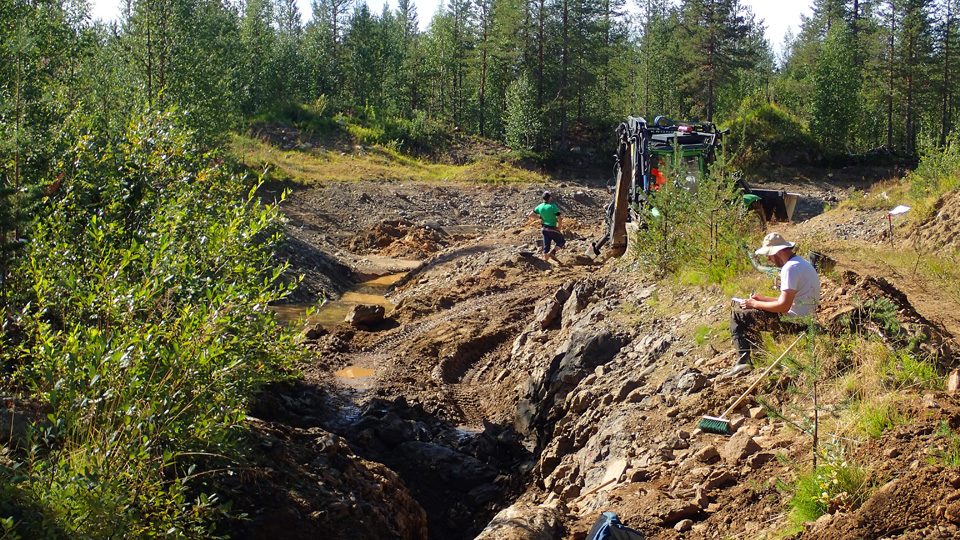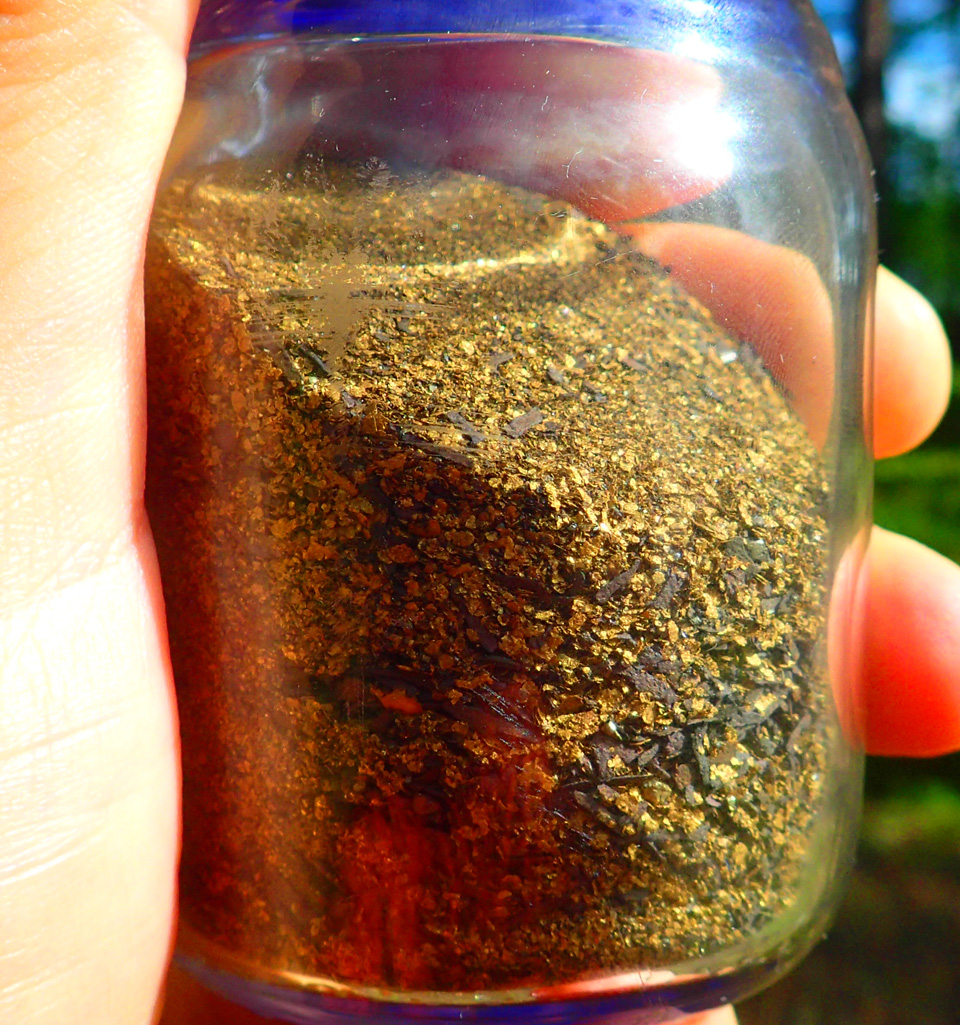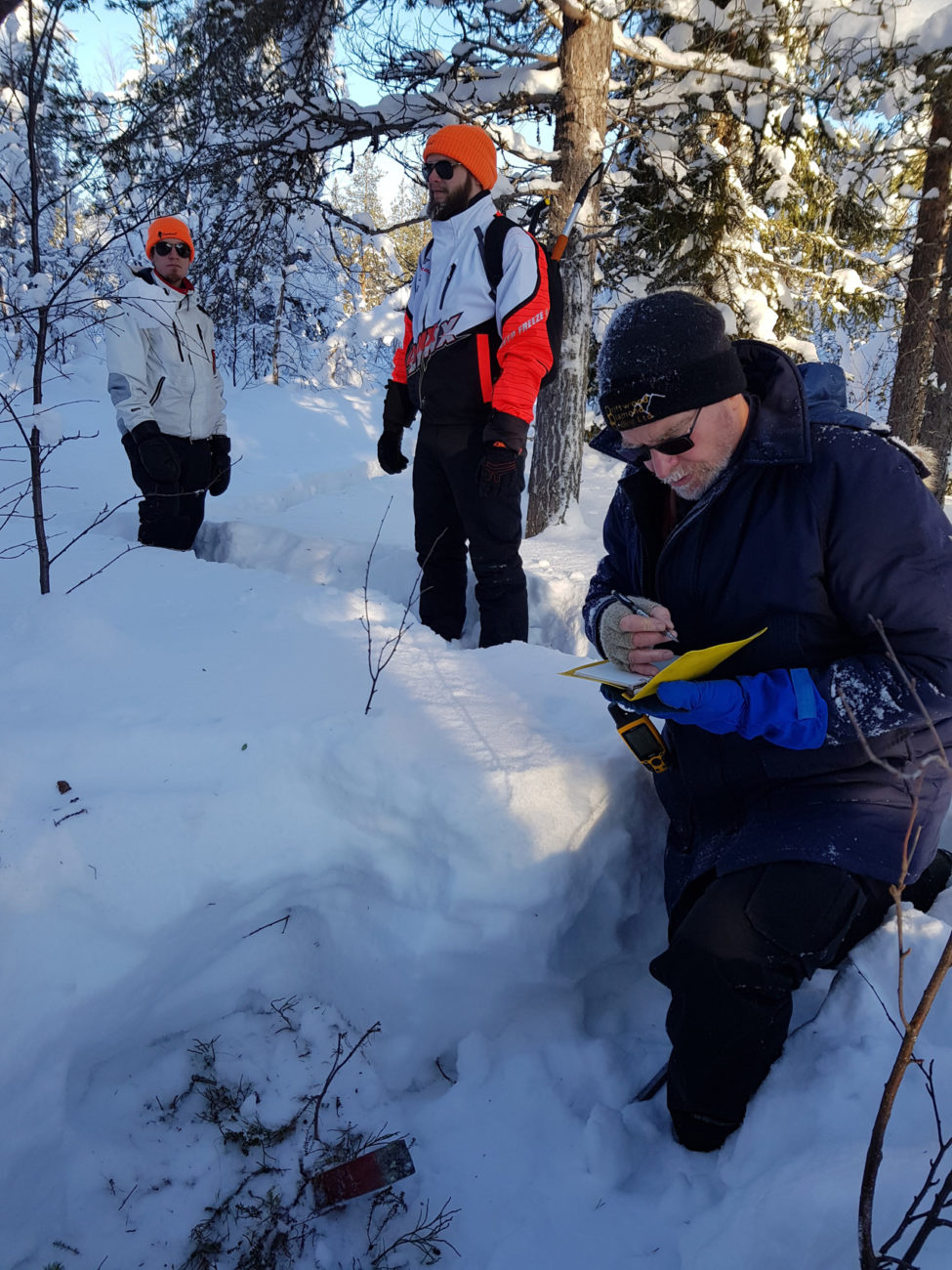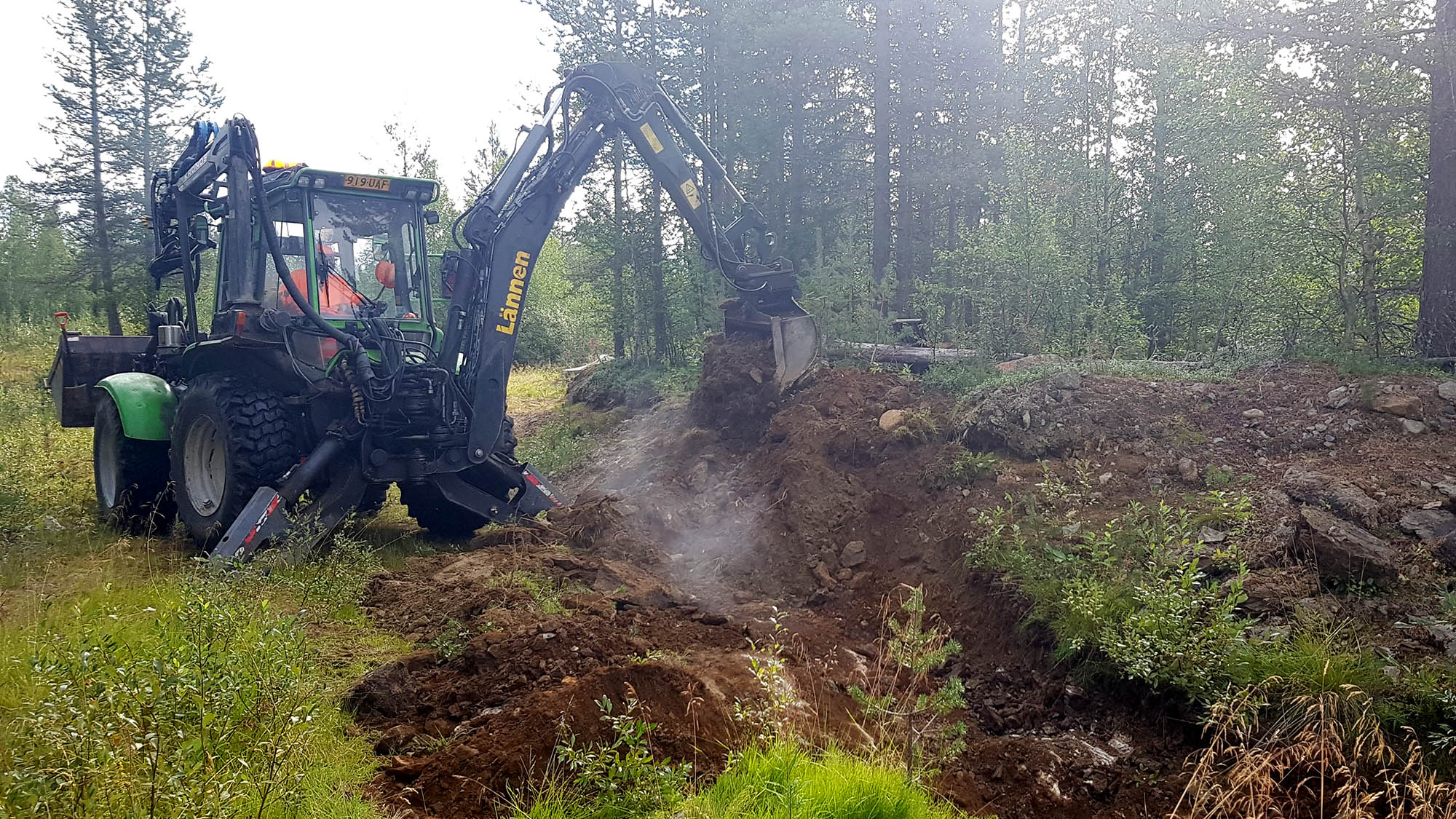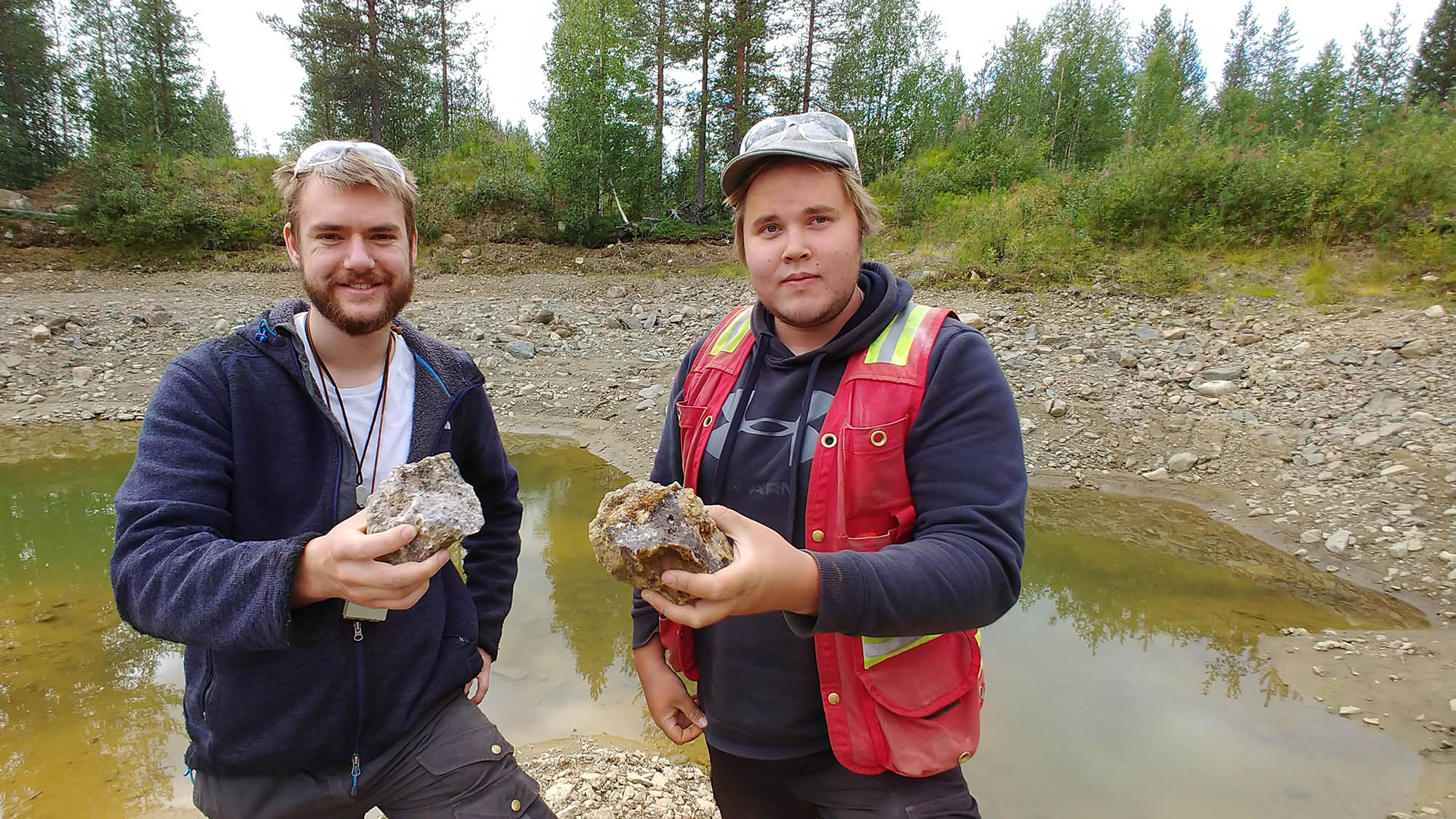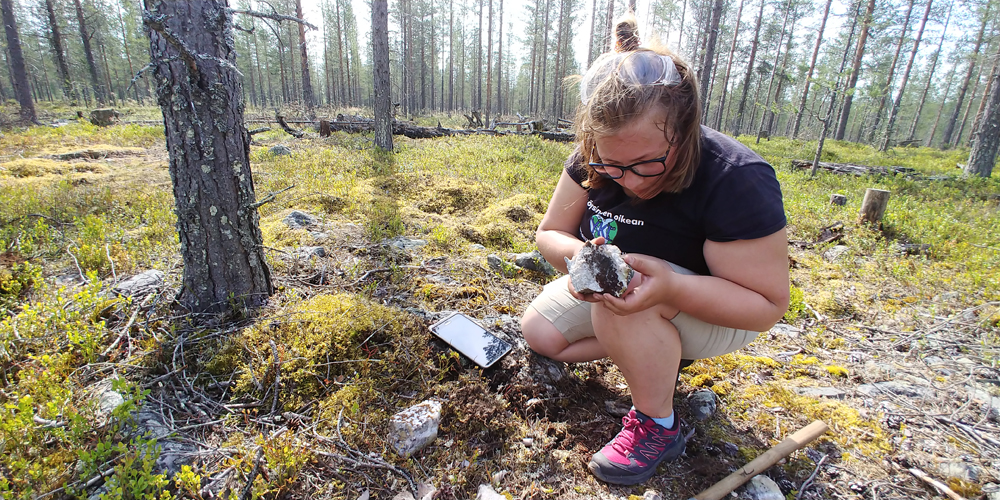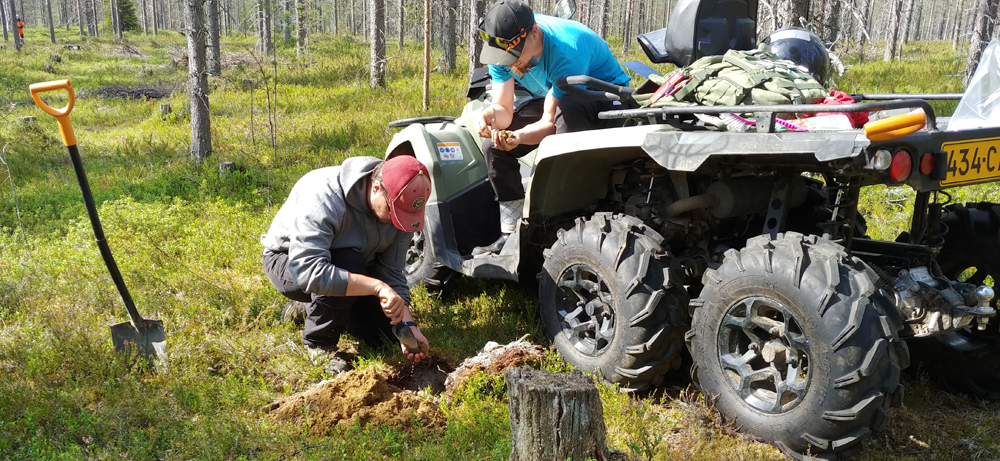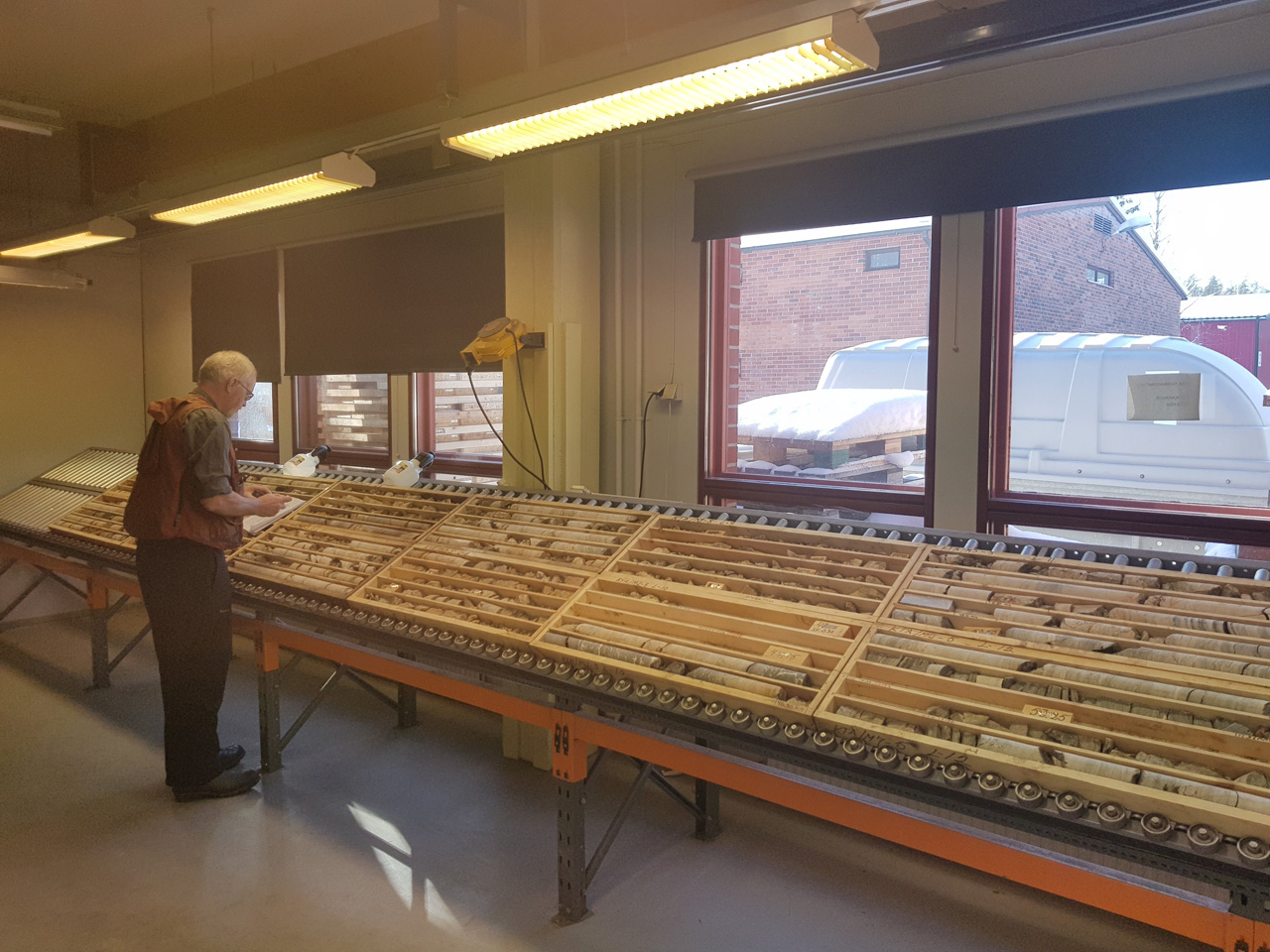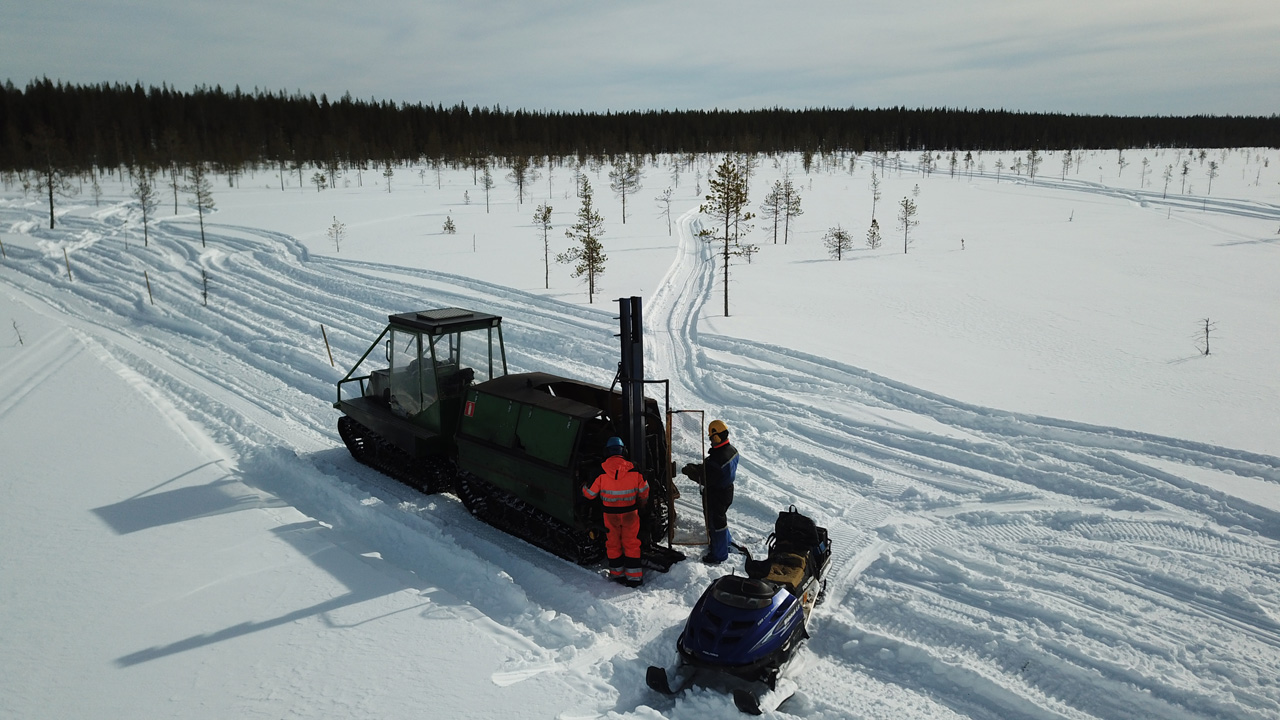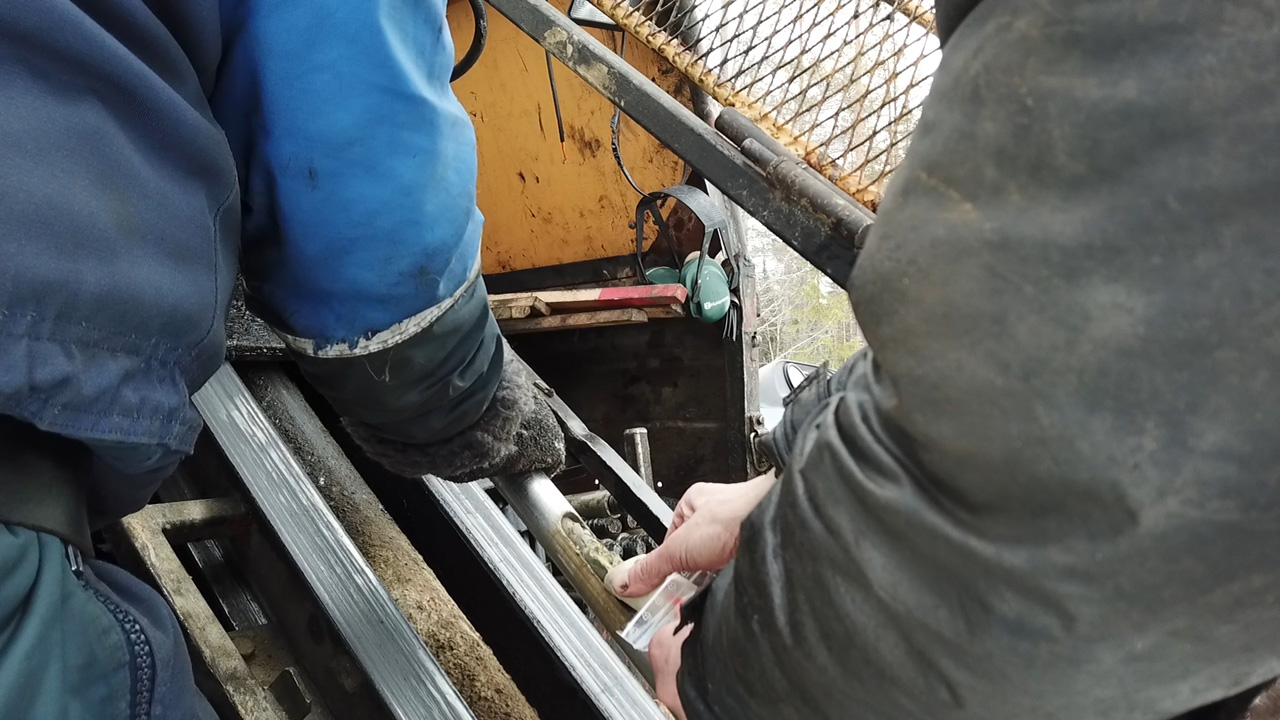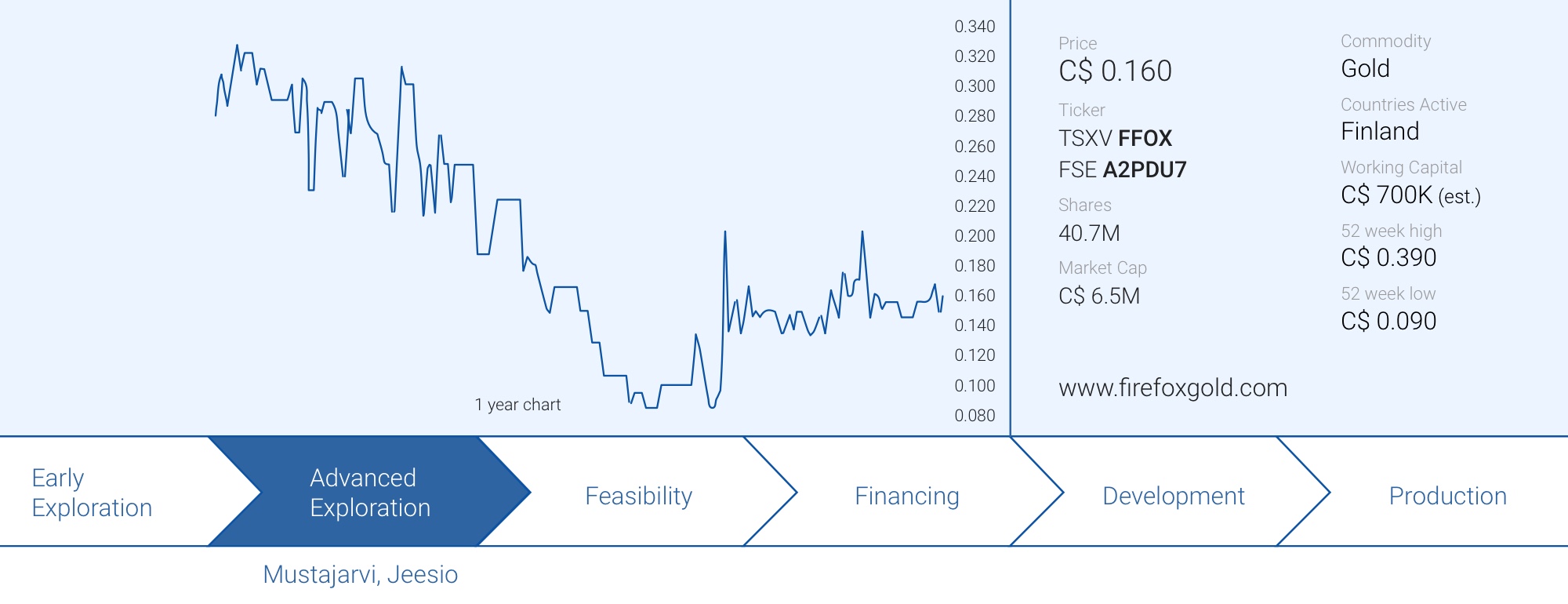
Finland would hardly be a country you’d think of when considering exploration companies. However, it’s not such a far-fetched idea as senior producer Agnico Eagle Mines (AEM, AEM.TO) has been a successful producer in Finland for years now and its Kittila gold mine is the largest gold producer in Europe. You may also remember Dalradian Resources (DNA.TO) had locked up the greenstone areas in Norway, and recently Aurion Resources (AU.TO) and S2 Resources (ASX:S2R) grabbed the headlines with new gold finds in Finland’s main greenstone belt.
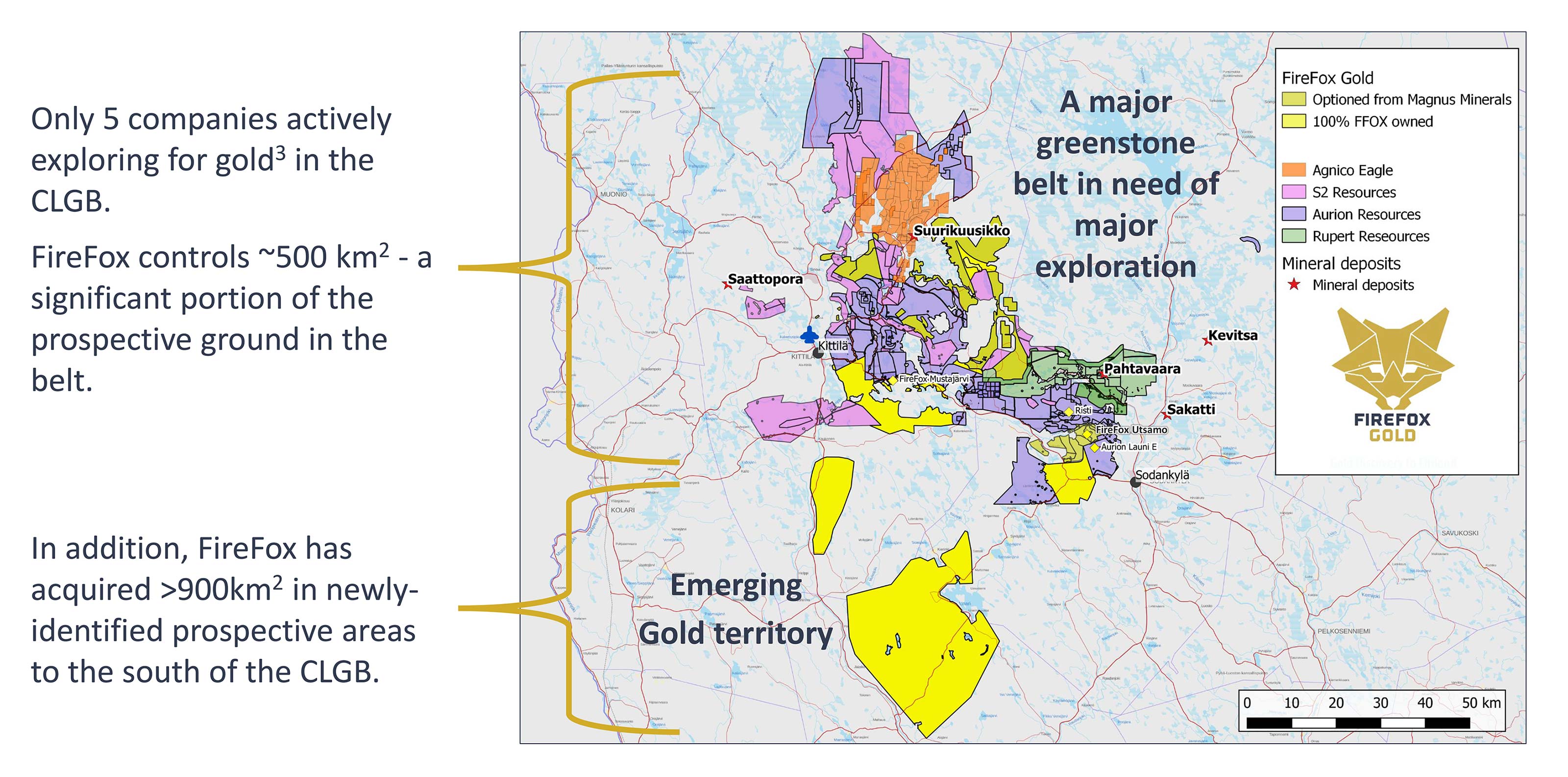
Entering the scene, Firefox Gold (FFOX.V) that has assembled a large land package in Finland’s greenstone belt. Two of the company’s properties are drill-ready, and after having completed a Phase I drill program earlier this year, Firefox is gearing up for a follow-up winter exploration program, and drilling has already started on the Mustajarvi project.
In a way, it’s great for Firefox Gold to have the second mover advantage as drill results published by Aurion already confirmed the potential for high-grade gold finds, so the area has already drawn some interest from (mainly Canadian) investors.
And to keep things simple, we removed some specific accents from the project and city names.
Why Finland? And why Lapland?
Although most people associate Scandinavian countries with countless lakes, endless forests, and a community embracing the life outdoors, one tends to forget that Finland is one of the few ‘true’ mining countries in Europe.
It has a long history of mining activities and has a very smooth and straightforward permitting process, clearly geared towards a transparent and straightforward system. It doesn’t mean the process is easy as after all, protecting the environment is priority number one for the Finnish mining ministry, but the legal framework is very clear and transparent. Companies cutting corners will fail. Companies following the permitting process wanting to build a mine up to the highest international standards should get the nod of approval without too many restrictive requirements. These elements resulted in Finland ending up on the third spot of the Fraser Institute mining survey policy perception index. An excellent achievement for a country which has only been open to foreign investment in the mining space for just 25 years (until 1995, the country’s mining scene was to a large extent essentially a duopoly as GTK and Outokumpu were both government-run enterprises and were focusing on base metals).
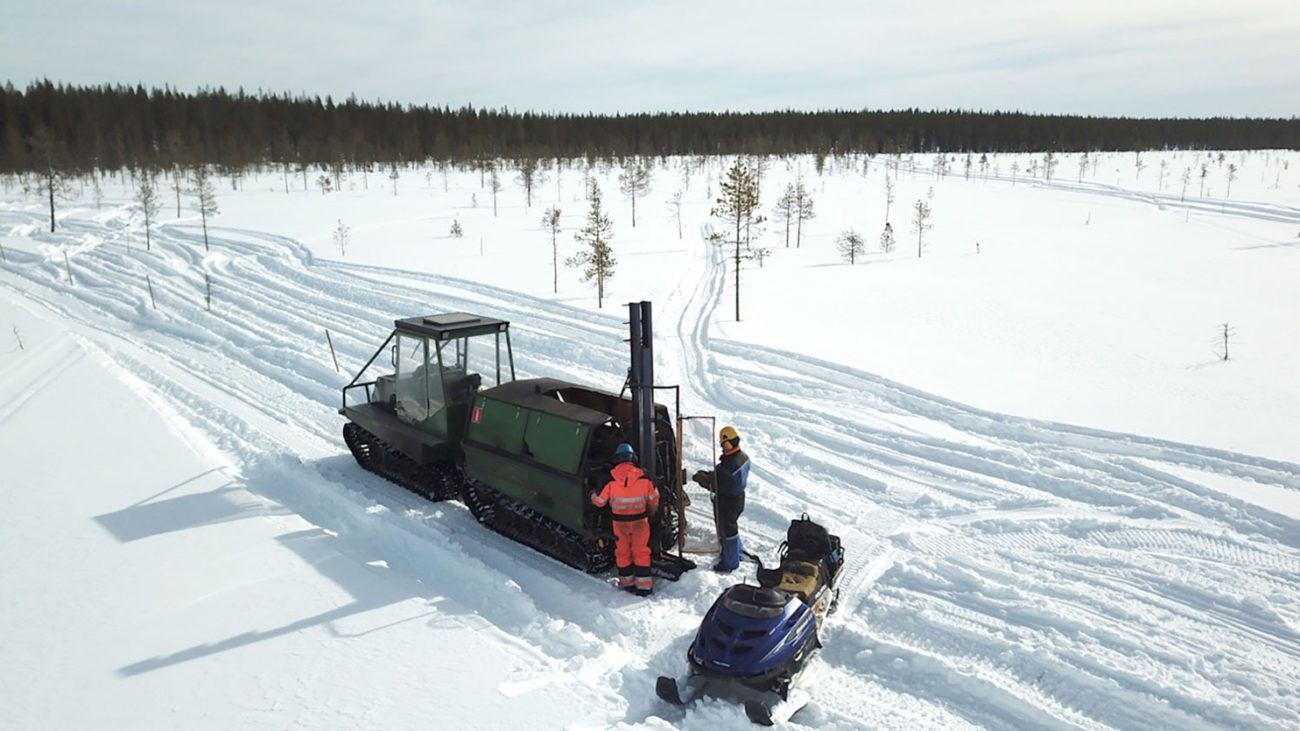
The exploration scene in Finland is pretty liberal. It’s standard practice to establish public access to all land, and this allows mining companies to do some early-stage exploration (think about mapping and some preliminary sampling programs) as long as the land doesn’t get damaged (i.e. don’t build a drill pad). Should an exploration company find a specific area of interest, it can apply for a Reservation Notice. This notice is valid for 24 months and reserves the exclusive right to apply for an exploration permit.
Once a company feels comfortable enough there’s perhaps something to be found there, it can apply for an Exploration Permit which is valid for an initial 4 years and can be extended for 3 additional 3 year periods and a subsequent 2 year period. So as long as a company keeps the claims in good standing (by making the relevant payments to the landholders based on a set fee per hectare which ranges from 20 EUR per hectare to 50 EUR per hectare depending on how long you have had the exploration permit), it can maintain the exploration permit for a total period of 15 years. An exploration permit gives a company the green light to do pretty much anything it wants (exploration-wise, obviously), except for processing the rock, for which a Mining Permit is needed.
The main area we will focus on in this report is the Central Lapland Greenstone Belt. A mouthful, so we’ll abbreviate it to ‘CLGB’ from here on.
The CGLB hasn’t been thoroughly explored yet (due to a lack of expertise, the semi-duopoly, and the focus on non-precious metals), and in the past 30 years of exploration activities on the Lapland Belt, approximately 13 deposits holding a combined 9 million ounces of gold were discovered. Nice, but not jaw-dropping. Especially not when compared to the Abitibi greenstone belt which hosts 100 mines with a combined production coming up close to 200 million ounces.
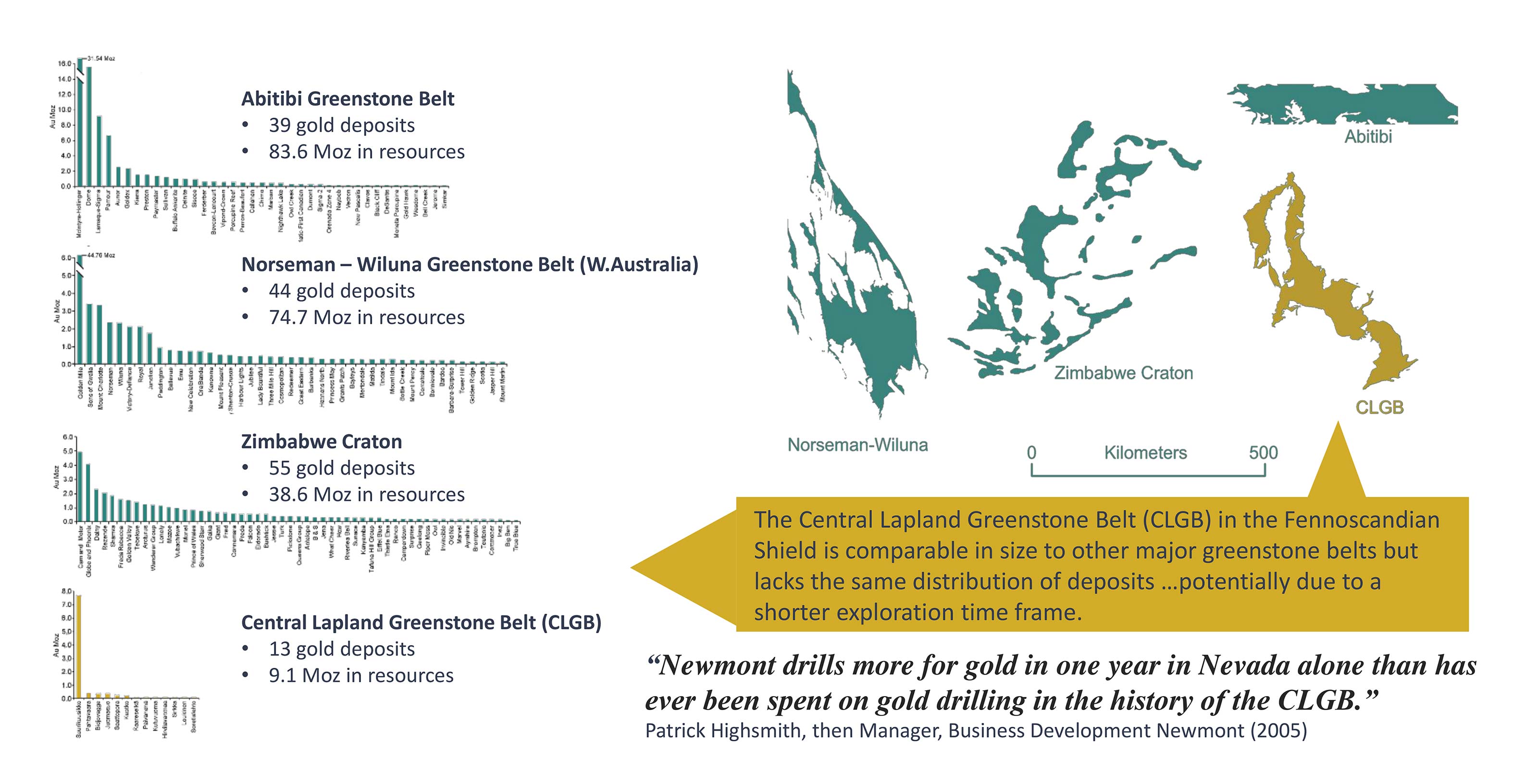
Does this mean the CLGB is a copy of the Abitibi with a similar amount of gold waiting to be uncovered? Not at all. But it does indicate that if you’re exploring for gold in Finland, that greenstone belt is ‘the place to be’ and is underexplored as the interest in the CLGB only gained momentum in the late 2000’s when Agnico Eagle opened the Kittila mine and showed the world how profitable mining in Finland could be. In fact, the main focus on gold only started just 5-6 years ago, so this is a virtually untouched greenstone belt.
Additionally, there’s an interesting historical angle here as well. Once the mining sector in Finland was opened up for foreign investment, the CLGB was staked by companies that were pursuing base metals: First Quantum Minerals (FM.TO) and Anglo American (AAL.L) were the dominant landowners. They couldn’t care less about the gold as they were looking for large base metal deposits just like Boliden’s Kevitsa mine, a copper-nickel mine with Platinum and Palladium as by-product credits, and Anglo American was successful as it discovered the Sakatti project (also a Cu-Ni-PGM project).
So it’s really just since about 5 years that exploration companies have had a dedicated gold-focused approach in Lapland. And that means the entire greenstone belt is in its infancy with regards to exploration.
Zooming in on the two main properties: Mustajarvi and Jeesio
1. Mustajarvi
The Mustajarvi project is a 1.5 square kilometer area in the Kittila region of Finland, the town that lend its name to the Agnico Eagle gold mine in the greenstone belt. The entire land package consists of just one exploration permit which was granted in December 2017 (as you remember from the previous section, this means Firefox should be able to keep the permit in good standing until December 2032 if it obeys the rules and fulfills all requirements).
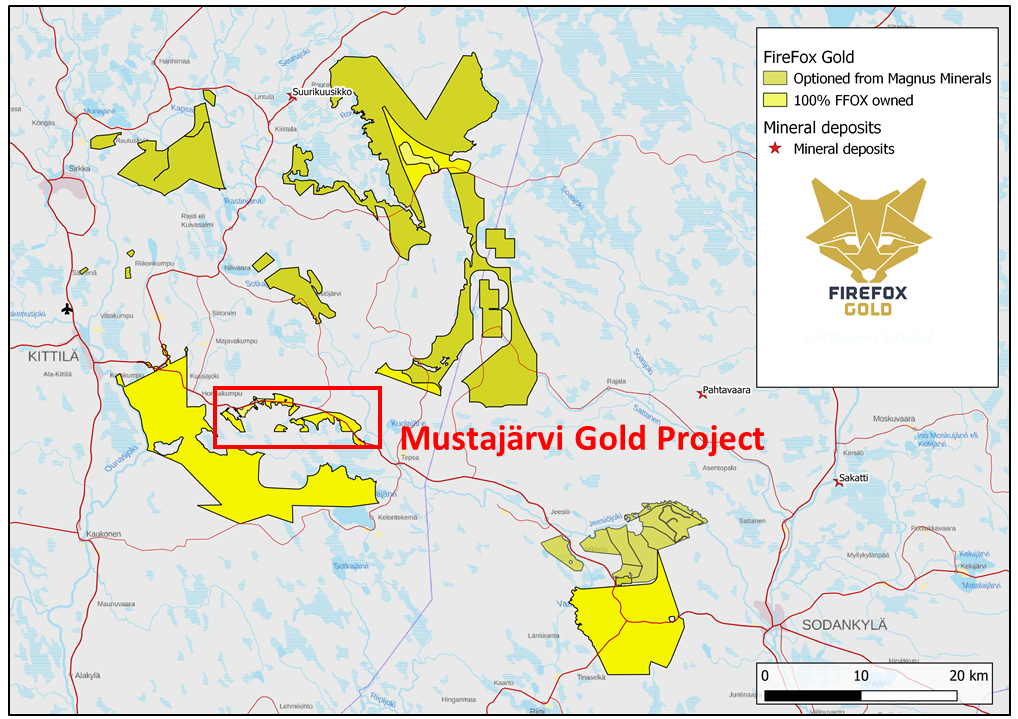
One of the main reason why the Central Lapland Greenstone Belt is so attractive is the presence of existing infrastructure. Highway 80 which connects the cities of Kittila and Sodankyla runs right through the Mustajarvi claims. Additionally, the entire region is very much pro-mining as both Agnico Eagle (Kittila Gold mine) and Bolliden (Kevitsa nickel-copper mine) have active operations within a 60-kilometer radius from both Kittila and the Mustajarvi project.
The gold mineralization at Kittila was initially discovered in the late 1980s when Outokumpu detected anomalous gold values in till samples where after a more methodic till sampling program confirmed the existence of gold mineralization. Enough evidence for Outokumpu to direct a drill rig to the property and 12 very short holes (averaging less than 60 meters) were drilled on the gold-in-till anomaly. Surprisingly, although they were very shallow, 11 of the 12 holes did encounter gold with an average grade of over 1 g/t, and two intervals really stood out: hole 1 encountered 2.7 meters at 14.58 g/t gold and hole 4 encountered a stunning 12 meters at 2.68 g/t gold.
Since Outokumpu walked away from the property, a few companies poked around and left. One of the previous owners of the property was Agnico Eagle that tried to drill three holes but encountered numerous problems, abandoned the holes and dropped the property. Mustajarvi was recently held privately by a gold panner (actually the chairman of the gold panning association) before it was added to Aurora Exploration (owned by Petri Peltonen – see later) and subsequently rolled into Firefox Gold. So Mustajarvi was basically ‘virgin territory’ until Firefox started working on the claims.
It completed a first drill program in 2018, and the summary of the drill results is another reason why we enjoy Firefox’s transparency. Of the 8 holes that were drilled as part of a 1,100-meter drill program, 6 holes contained gold. A 75% success ratio is excellent, but Firefox also still mentions the ‘empty’ holes in its corporate documentation, whereas most other exploration companies would just not refer to those holes.
So, a high level of transparency at Firefox Gold, and the six remaining holes encountered interesting zones of 4.1 meters at 1.87 g/t gold (including a very narrow 35 centimeters of 11.63 g/t gold, which means the remaining 3.75 meters contained about 0.96 g/t gold) as well as 3.65 meters of 0.97 g/t gold, and 2 meters containing 45 g/t gold and 0.16% cobalt.
Most of the 2018 drill intervals were quite short (0.5-2 meters), but Firefox is still just zeroing in on its targets. The grades are absolutely excellent for mineralization this close to surface, but we hope this year’s drill program will encounter some thicker intersections.
2. Jeesio
The Jeesio property is substantially larger than Mustajarvi as it consists of a total of 460 square kilometers subdivided into an exploration permit and reservations. Similar to Mustajarvi, the access to existing infrastructure is absolutely excellent as parts of the land package are actually overlapping highway 80 while there are two powerlines readily available on the north and south side of the Jeesio project.
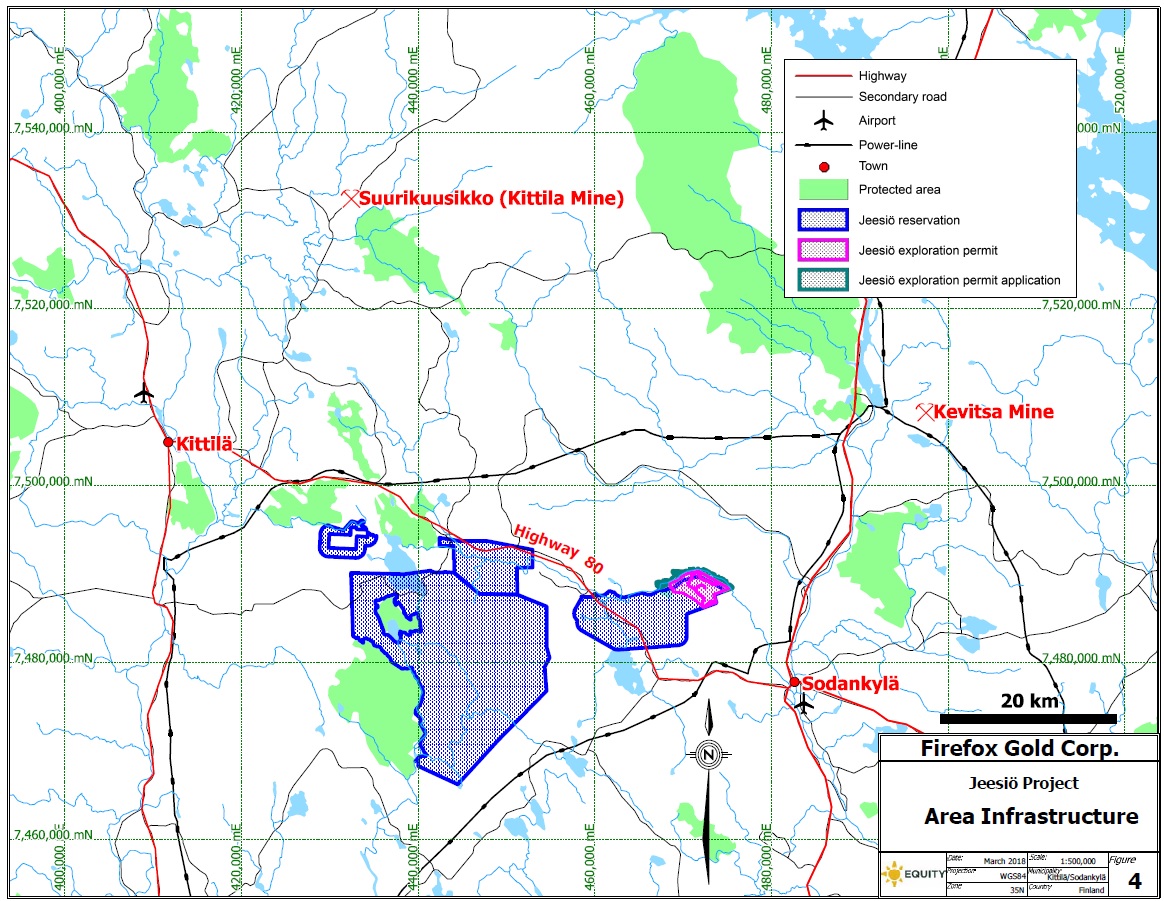
There’s one specific area of the Jeesio project that we are very interested in. The Utsamo zone which is a part of the Jeesio target is located literally in between the two gold discoveries made by Aurion Resources. As you may remember, Aurion found gold at both Risti (with intervals of for instance 28 meters containing 9.42 g/t gold and 31 meters containing 3.51 g/t gold) as well as Launi East (which hasn’t been drilled yet, but the recent sampling program returned high grade gold assays, not unsimilar to what Aurion discovered at Risti).
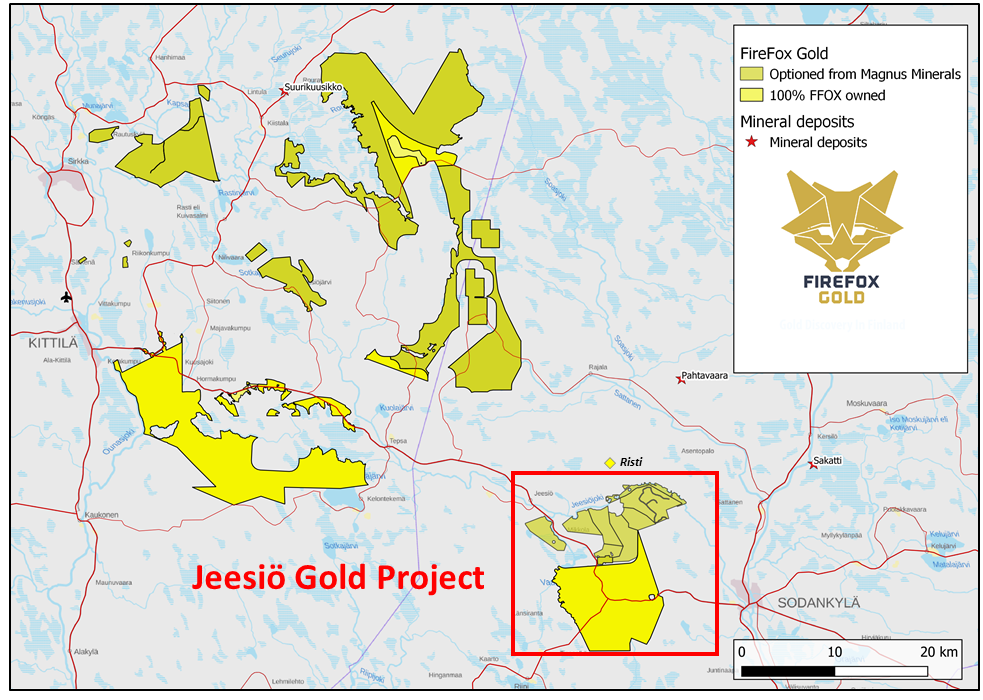
Of course, that doesn’t mean the gold zones continue through the Utsamo target, but as far as a ‘nearology play’, the Utsamo zone is a very interesting piece of real estate as it could be the missing link between Risti and Launi as a magnetic survey has identified a 2.8 kilometer long target which Firefox’ geos think is a part of the Sirkka shear zone that does look like it’s continuing onto the Aurion properties:
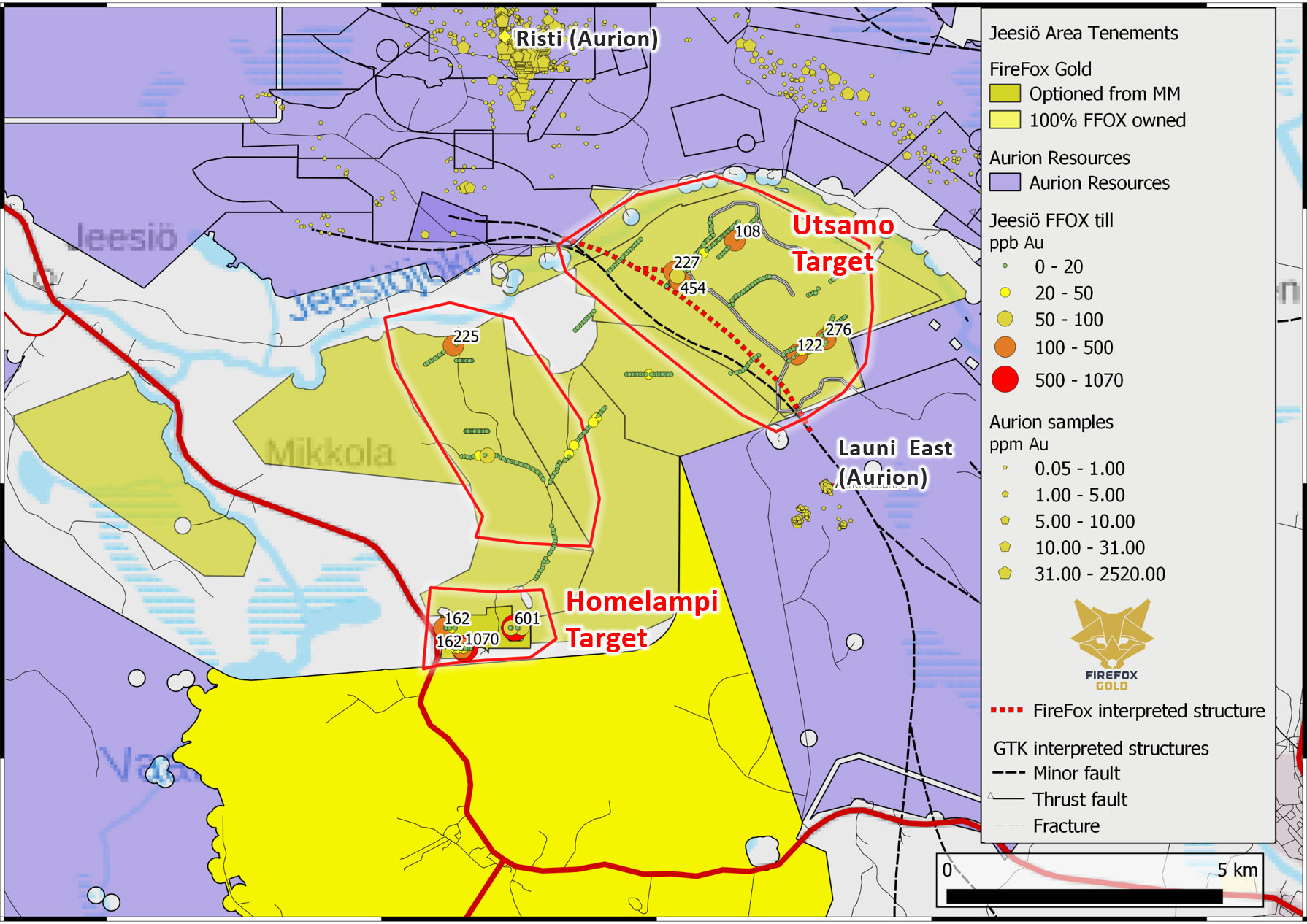
This exploration target was further validated by Firefox’ sampling program where it outlines several gold in till anomalies, while the structural interpretation appears to be following the contact between the meta-sediments and mafic intrusive rocks.
Again, there’s absolutely no guarantee Firefox will find anything economic. But having all these elements and knowing another exploration company actually did find (high-grade) gold on both sides of the structure makes this a very juicy exploration target, and we are happy to see Firefox is planning to drill-test the Utsamo target this quarter. As we are very impressed with the methodological drill program at Mustajarvi (see later), we expect Firefox to have a well thought out plan for Utsamo as well once it solves its luxury problem.
And Utsamo does create a luxury problem for Firefox as it looks like there are several promising targets (and we expect additional groundwork to unveil even more targets). So even if the first holes don’t intersect (high-grade) gold mineralization, the Utsamo zone should definitely not be written off. It’s a large zone and we can’t really expect the company to make a discovery with the first few holes.
But there are other assets in the portfolio as well
We zoomed in on Mustajarvi and Jeesio/Utsamo as those will be the two projects that will provide the catalysts for Firefox. But Firefox owns much more than just those two projects and although we won’t go too deep into the non-priority targets right now, it is worth highlighting some of them.
The Seuru gold project (which contains over 50,000 hectares of land under an exploration reservation), for instance, contains two interesting target zones within walking and trucking distance from Agnico Eagle’s Kittila mine. The Lauttaselka target is very close to the Kittila mine and is located right on a highway that provides direct access to the Kittila processing plant.
Firefox still has other properties but we’ll keep those for another report as the current focus is on Mustajarvi and the Utsamo targets.
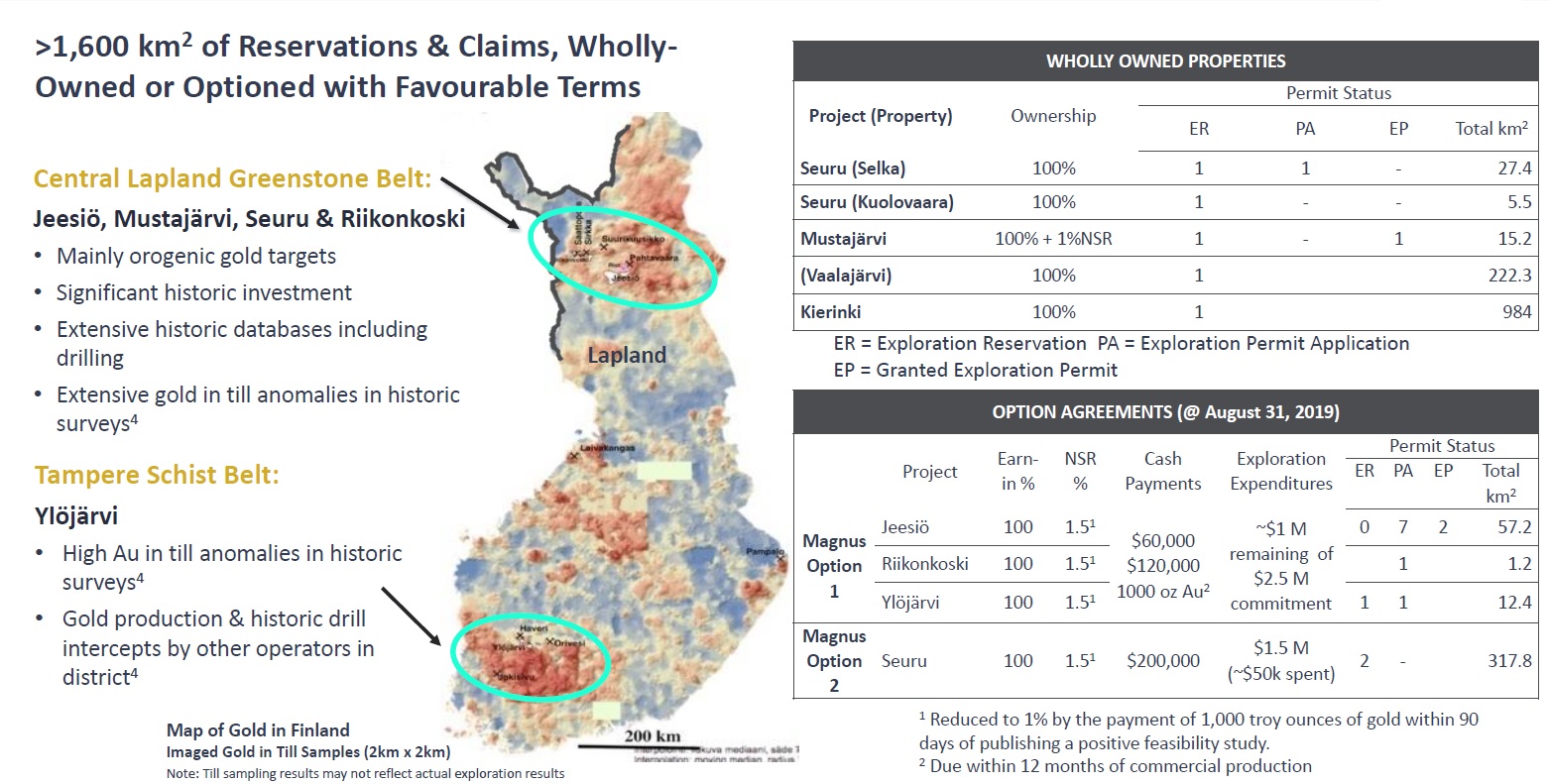
Drilling has already started at Mustajarvi
Drilling is already underway as Firefox has initiated a nine-hole drill program on the Mustajarvi zone, where up to 1,500 meters will be drilled. The first four holes will zoom in on the high-grade results that were encountered in last winter’s exploration drill program (with for instance 2 meters containing just over 45 g/t gold) and two holes will test the ground for mineralization an additional 25 and 50 meters down dip, while the remaining two holes will try to expand the mineralization by 25 meters both to the east and the west. Small steps, but these four holes will provide Firefox with a lot of geological data that could then be used to design additional exploration programs.
In fact, the entire drill program is mainly about gaining more knowledge of the deposit as holes 5&6 will focus on the areas that have previously been drilled by Outokumpu, which encountered additional high-grade zones. One hole will test for the continuation of this mineralization, while hole 6 will try to twin one of the historical holes in an attempt to recover more of the core (which will help with the interpretation of the structures) as Outokumpu’s drill program had very poor core recovery results due to faults and fractures in the rock.
Holes 7-9 will be the bigger step-out holes as Firefox would definitely like to test whether or not it has a potential elephant by its tail. Two of the three final holes will be drilled almost half a kilometer away towards the northeast while the final hole will be a stepout hole 250 meters in the opposite direction (southwest). As such, these three holes will provide a preliminary indication of the mineralized zone over a 700 meter strike zone.
Running a tight ship with a low G&A
We are always very impressed when a company is able to keep its overhead expenses low. While some exploration stage companies have a corporate overhead of millions of dollars per year, Firefox Gold has applied the correct mindset right from the beginning.
In the first six months of the year, Firefox’s total expenses were C$711,000. This doesn’t sound low but once we filter out the C$418,000 in exploration efforts that were expensed rather than capitalized, the true corporate overhead was less than C$300,000 for the first semester. Remarkable, and 60% of the total expenses were spent on the properties. That by itself is already a good ratio but in a recent phone call with CEO Carl Löfberg, he indicated he wants to see that ratio increase to at least 70%. That shouldn’t be too difficult as a C$250,000 hike in exploration expenses would already accomplish that. But honor where honor is due, and Firefox scored some bonus points with us for its excellent financial stewardship.
As of the end of June, Firefox had a working capital position of around C$350,000 (including C$430,000 in cash) and the recent raise which was completed last month didn’t come as a complete surprise.
Within two weeks after announcing a financing of ‘up to C$1M’ Firefox already closed its second and final tranche raising a total of C$570,500 by issuing 3.8 million units. Each unit consisted of one common share as well as a full warrant allowing the warrant holders to purchase an additional share at C$0.20 during a two year period.
The financing was ‘priced to sell’ with a very attractive warrant (which could act as some sort of ‘secondary financing’ further down the road as the 3.8 million warrants would bring in an additional C$760,000), and although Firefox initially mentioned a raise of up to C$1M, it was happy to close on just over half of that amount instead of leaving the financing open. After looking at the company’s financial statements, Firefox appears to have a very low overhead cash burn with almost 70% of the expenses effectively being spent on the project to make more targets drill ready.
And although Firefox raised just over half a million Canadian Dollar, CEO Löfberg appears to be very confident this will carry the company to January/February and by then, the assay results from the fall drill program should be out. If those drill programs are successful, Firefox should be able to top up its treasury on the back of those results.
Management
Carl Löfberg, CEO & Director, MSc
Mr. Löfberg has a Master’s degree in Industrial Economics and broad experience in business consulting, project management, company start-ups and financing. As an economist and precious metals investor, he is an expert in hard currency and contrarian business strategy. Mr. Löfberg is a founding member of FinnAust Mining Plc, a JV company with Australian nickel miner Western Areas NL, which is now listed on the AIM-exchange in London. He has been Managing Director for Magnus Minerals since 2006.
Patrick Highsmith, Chairman, MSc, CPG
A professional geologist and mining executive with 29 years of
experience in exploration, operations, business development & leadership roles for companies, including: Rio Tinto, BHP Billiton, Newmont, Lithium One, Pure Energy Minerals, and Fortescue Metals Group. Mr. Highsmith has worked on more than 250 projects around the world, leading teams through creative transactions, new discoveries, scoping, and prefeasibility studies. He is experienced in the capital markets, having been associated with all manner of financings and transactions. Patrick has been targeting gold in Finland since 2005, and has been integral in building FireFox. He is currently Group Manager, Business Development for Fortescue Metals Group.
Timo Mäki, Director
Mr. Mäki is an experienced geologist who resides in Finland. He was
most recently the Chief Geologist at First Quantum’s Pyhäsalmi Mine, where he worked from 1988-2018. He is credited with the discovery of the Mullikkoräme zinc deposit in 1987 and Pyhäsalmi deep deposit in 1996. Mr. Mäki is currently on the scientific advisory board of the K.H. Renlund Foundation and the EU Horizon 2020 project “Next”. He also served on the board of the Finnish Mining Association from 2013-2016. Mr. Mäki has a Master’s of Science (Geology and Mineralogy) from the University of Turku.
Petri Peltonen, PhD, Exploration Manager
Dr. Peltonen has over 25 years experience in geoscientific research, exploration and mining. He has deep experience on a variety of commodities & deposit types including: gold, copper porphyry, magmatic copper nickel, VMS, iron ore, and diamonds. Most recently he was engaged as Exploration Manager Europe for First Quantum Minerals Ltd. Dr. Peltonen is an accredited Chartered Professional of Australian Institute of Mining & Metallurgy (AusIMM), European Geologist (EurGeol), and SEG Fellow. He also serves as Professor of Economic Geology at the University of Helsinki.
Richard Goldfarb, PhD, Technical Advisor
Dr. Goldfarb has more than 40 years of experience as an exploration geologist, researcher and professor who has authored over 220 geological publications and given more than 200 keynote addresses and workshops in 31 countries. He is a world-renowned expert on the geology of gold deposits with an emphasis on orogenic gold. He rose to prominence during a 30+ year career as a Senior Research Geologist at the US Geological Survey. Dr. Goldfarb’s specialty is target generation and optimization in greenfields exploration for orogenic gold.
In addition to operating a well known geological consultancy, he is a Distinguished Overseas Professor at the China University of Geosciences and a Research Professor at the Colorado School of Mines. He is a Fellow and former President of the Society of Economic Geologists.
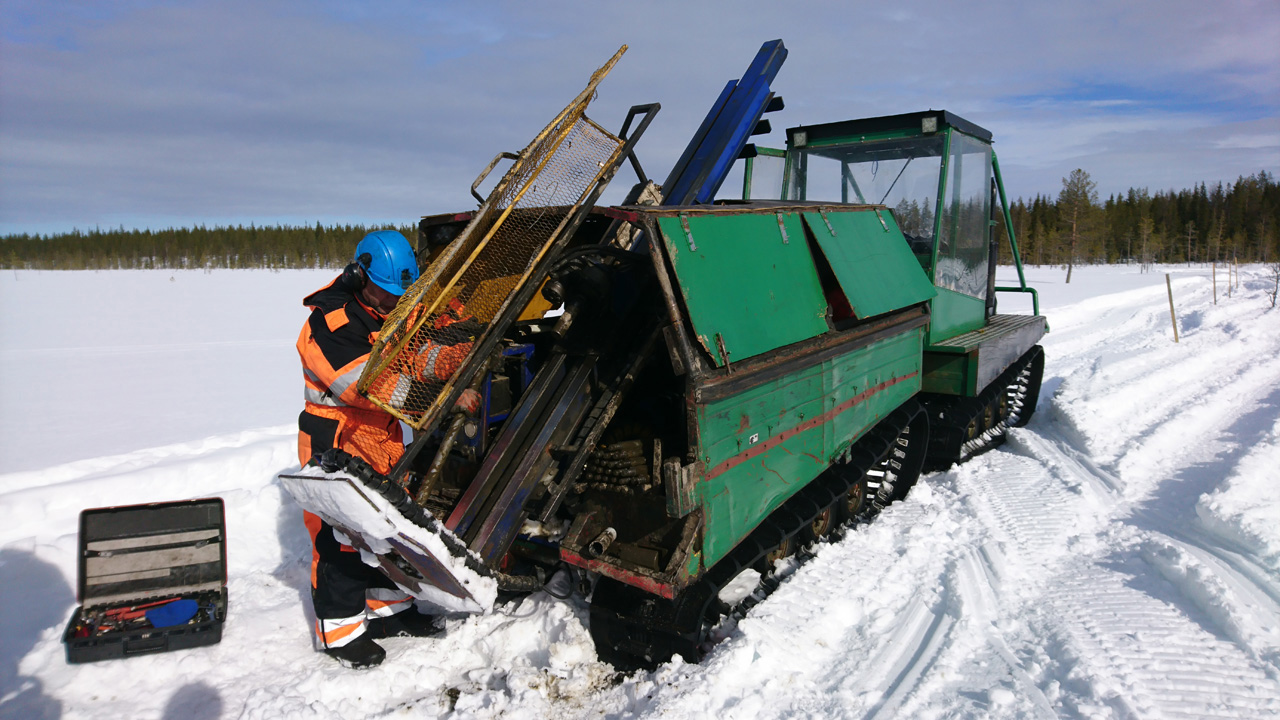
Conclusion
It doesn’t happen very often that an entire greenstone belt was up for grabs. Aurion Resources has the first-mover advantage, but Firefox Gold is benefiting from the second mover advantage: Aurion has proven it is possible to make new gold discoveries on the greenstone belt which will make it easier for Firefox to tell its own story and pre-prepare the market for exploration updates.
Drilling has started at Mustajarvi and as last year’s drill program already had a 75% success ratio, Firefox can just build onto that success in its pursuit to expand the gold system on the property. And with a current market capitalization of just over C$6M, the risk-reward ratio appears to be very interesting at Firefox Gold.
Disclosure: The author holds a long position in Firefox Gold. Firefox Gold is a sponsor of the website.
